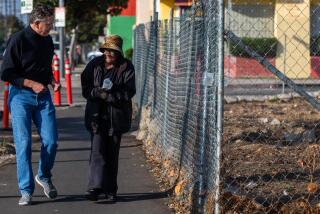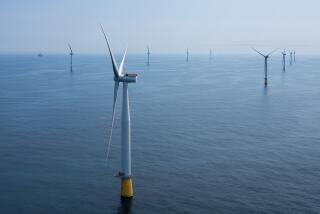Oil Rig, 9 Miles Offshore, Is Home and Work Above the Sea
Workers aboard this vast, rumbling network of pipes and compressors call her an animal--a volatile creature with good days and bad. Her moods swing, her pressures shift and her lifeblood flows from black pools two miles below the sea floor.
This is Platform Gail, one of the largest and most sophisticated offshore oil rigs in California--a small city sitting in almost 800 feet of ocean nine miles off the coast of Port Hueneme.
At 900 feet tall, she is a virtual skyscraper at sea, just 300 feet shorter than the Empire State Building. Her base, just above the water, is the size of a football field. Day and night, Gail sucks up oil and gas, sending it roaring through pipelines to storage tanks in Carpinteria.
She pumps about 4,500 barrels of oil and 10 million cubic feet of natural gas every 24 hours. She desalinates water for the crew, filters poison gas from the oil and makes her own electricity.
Those aboard Gail sometimes seem less like technicians and engineers than cowboys atop a bucking bronco.
âItâs a low-risk, high-consequence environment,â said Sally English, the platformâs supervisor and the only woman working on Gail. Even with the latest safety equipment and backup systems, the consequences of an accident are enormous.
Employees conduct daily emergency drills but try not to let the hazards of the job interfere with the work. Many are seasoned offshore employees. They are used to life on a swaying maze of steel girders above a rolling sea. Their noses are conditioned to the pungent odor of petroleum, their ears dulled to the din of machinery.
They work seven 12-hour days, then go home for seven days. While on board, most share small, dorm-like rooms. For entertainment they watch television, call home or exercise in the recreation room. Alcohol is forbidden and smoking severely curtailed. A stray spark outside designated areas will be detected by sensors that shut down operations and flood the area with thousands of gallons of water.
But this life holds an attraction and camaraderie that few jobs can match. The environment is always changing, there is an element of risk and marine wonders abound. The money isnât bad either, with salaries starting around $40,000 a year and topping $100,000.
âI worked two weeks on land once and I couldnât take it,â said Javier Marin, a 39-year-old from Oxnard who has worked on platforms since he was 18. âI said put me back offshore.â
Sea Commuters
A trip to Gail begins at the Port of Hueneme, where workers board the 115-foot boat Wendy Tide. Depending on the weather, the trip can be a pleasure cruise or a nightmare.
On a recent day, luck was with them; the seas were tranquil but foggy. A whale spout appeared nearby and pelicans wheeled overhead.
âItâs not a bad commute unless the seas are high,â said Steve Metheny of Ojai. âIâve seen a lot of macho men go down.â
Metheny, 54, visits Gail three times a week to monitor its chemical supply. There are engineers, technicians and a lifeboat repairman aboard. Some will return that afternoon; others will stay a few days.
Laura Kranzler, 33, is an engineer with Venoco, the Carpinteria-based company that owns Platform Gail along with the smaller platforms Grace and Holly. Kranzler visits Gail to make sure nothing leaks aboard the platform. Hydrogen sulfide is a constant threat.
The highly poisonous and flammable gas is a byproduct of the petroleum extraction process. It can kill quickly and with little warning. Workers train daily on what to do and where to go in the event of a gas leak.
An hour passes. The boat captain steers carefully in the dense gloom.
Slowly, out of the mist, a towering structure emerges like a spaceship in a cloud. There is a long telescoping arm with flames fed by natural gas roaring from the end. Metal stairways and steel grates crisscross the three-story platform. Radar dishes jut from one side. The small figures of men climbing stairs and operating cranes become visible.
âWhen you first come out here, you are just in awe because it is so complex,â said Metheny, looking up at Gail. âBut after a while, you realize itâs a little city.â
A crane high above lowers a circular rubber basket to the boat deck. Workers put on life jackets, step onto the side of the 10-foot-wide basket and grab the ropes that suspend it. The crane winches them up. They rise 50 feet, 100 feet, 150 feet. Winds buffet the basket.
âThink weâd make it if we fell?â asked one man, looking at the sea below.
âMaybe,â replied another. âMaybe.â
The basket is set down on the platform.
On board, dozens of workers in blue overalls, plastic glasses and helmets walk through alleys of pipes and drills. The smell of gas and oil strikes like a fist and the air vibrates with the sound of pumps and compressors. Orange âDANGERâ and âPOISONâ signs are everywhere.
A container ship resembling a floating hotel creeps past a few miles away. The platform, which accommodates up to 93 people at a time, is equipped with a radar enhancement device that makes its image appear larger than it is to warn off ships from straying too close.
English, who runs the rig, is a 20-year, no-nonsense veteran of oil fields and offshore platforms.
âOverall, itâs not a problem being the only female. This is the oil business; itâs blue collar. How often do you see women in construction?â she asked. âMost of the guys I work with are interested in working. A small percentage are jerks.â
There isnât much time to be a jerk.
âThe level of activity here is extremely difficult,â said English, 48. âGail is a very busy place.â
Javier Marin, the lead operator, works in the nerve center of the platform. Three computer screens with images of Gailâs pumping, drilling and safety systems surround him. Numbers fluctuate on the screen. In an emergency, he can push a single green button to shut down the entire platform.
âThis place is the toughest platform I ever worked on. This is an animal to run,â said Marin, who also worked on platforms in the Beaufort Sea near Alaska.
âThere are so many systems here,â he said. âIâm evaluating everything. I am looking at all the different pressures. You got times when levels come up on you quickly, and you need to react and keep your cool.â
Platform workers regulate Gailâs pressures, cool her when she gets hot, slow down or speed up oil production, and constantly tune up the electrical systems. Roustabouts unload great boxes of cargo lifted by cranes. They climb ladders 150 feet over the ocean and do the heavy lifting and maintenance aboard the rig. And then there are medics, cooks and contractors aboard.
David Marsh, the chief operator and Marinâs boss, lives in Clovis, Calif., and began his oil career in Wyoming. He said it takes years to fully comprehend Gail.
âIt has good days and bad days,â the 41-year-old explained. âYou learn how to handle stress, to be smart and have quick reactions. One thing I can compare it to is the nuclear business, because we are so regulated. Safety is an all-encompassing job.â
Gail is one of 32 oil platforms off the California coast, 23 of which are in the Santa Barbara Channel.
Accidents are rare but not unknown. The worst occurred in 1969, when a Union Oil Co. platform drilling a mile under the sea hit a high-pressure pocket of petroleum that sent millions of gallons of oil onto the beaches of Summerland and Santa Barbara.
Since then, the biggest spill was in 1997. A platform operated by Nuevo near Vandenberg Air Force Base had 6,500 gallons of oil pour from a ruptured pipeline.
Offshore platforms give California about 200,000 barrels of oil a day, with another 600,000 coming from onshore operations, said Mike Edwards, vice president of Venoco.
John Martini, head of public affairs for the California Independent Petroleum Assn. in Sacramento, said there are 20 trillion cubic feet of untapped natural gas sitting off the Western United States, with most of it off the California coast. If utilized, he said, the natural gas could greatly alleviate the energy crunch.
âThe resources can be and have been produced in a very safe and environmentally sound way,â he said.
But a spokesman for Gov. Gray Davis said there are no plans to expand offshore drilling.
âThe governor is focusing on building more power plants, and I donât see how increased drilling would get more megawatts online,â said Roger Salazar, a Davis spokesman. âHe is open to looking for other sources of energy but not off the coast.â
The Minerals Management Service, part of the U.S. Department of the Interior, oversees oil development in federal waters and performs monthly safety inspections of Gail and other platforms.
âGail is one of our most complicated--if not the most complicated--platforms,â said Rishi Tyagi, district supervisor for the agency. âIt removes hydrogen sulfide from the gas, the oil and the water right at the facility.â
The Coast Guardâs Marine Safety unit in Santa Barbara said Gail has had three crude oil spills of less than a gallon each since 1999.
âIt was probably just a few ounces in their case,â said Lt. Yuri Graves, who commands the Coast Guard unit. âThey are very proactive and very good about reporting spills.â
Edwards said the platform should produce oil for at least another 15 years.
Gail was assembled in 1986. In 1999, Chevron sold it to Venoco. There are 22 oil and gas wells running beneath the platform. The drill heads are encrusted with diamonds, allowing them to bore through the toughest materials.
Marine life is drawn to all the hardware, using Gail as an artificial reef.
Sea lions play beneath it and massive purple sea stars cling to its pylons. Once a year, divers with high-powered hoses blast off the sea life encrusted on the legs. Whales sometimes move in to feast on the animals. Workers lowering traps to catch shrimp sometimes pull up strange-looking eels and other deep-sea creatures.
An Oil Life
Life on Gail means existing in close quarters with fellow workers and realizing you canât run out to get anything not already aboard.
The rooms are functional, not fancy, and the whole place can sway in rough weather. But the rooms are a welcome oasis from the noise, smells and elements outside. A narrow corridor leads inside the living area. One hallway goes to the galley and another to a stairwell.
Upstairs there is an unadorned room with a dozen or so soft chairs arrayed around a big-screen television. The men sleep in bunk beds with two or four to a room.
The schedule means crew members work only six months a year, but it still takes a toll on a personâs family life.
Marin said he missed the birth of both his sons because he was fogged in on a platform in Northern California. He eventually got divorced.
âThe work put a strain on my marriage,â he explained. âNot being able to get away is a problem. When youâre working, your mind is going nonstop. When I get off, I want to be alone.â
And when he gets home, he cringes when his children ask to visit the shore.
âThe last thing I want to do is go to the beach,â he said.
More to Read
Sign up for Essential California
The most important California stories and recommendations in your inbox every morning.
You may occasionally receive promotional content from the Los Angeles Times.










